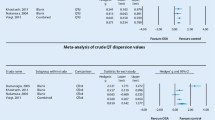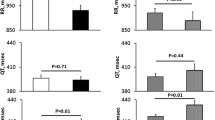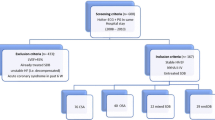Abstract
Background
Obstructive sleep apnea (OSA) is significantly associated with a higher risk of ventricular arrhythmia (VA). QT, the Tp-e/QT ratio, and QT dispersion (QTd) are used to evaluate myocardial repolarization and are highly correlated with VA. The aim was to evaluate the predictive value of the Tp-e/QT ratio and other electrocardiogram (ECG) parameters for nocturnal premature ventricular contractions (PVCs) in patients with OSA.
Methods
We retrospectively analyzed data from patients with OSA and conducted a 1:1 matched cohort study. Patients diagnosed with OSA who met our criteria for the PVC group, and sex- and age-matched patients with OSA who met our criteria for the control group were enrolled in the study. The Tp-e, Tp-e/QT ratio, corrected QT interval (QTc), corrected Tp-e interval (Tp-ec), and QTd were measured, calculated and analyzed.
Results
Patients in the PVC group (n = 31) showed a greater Tp-e, Tp-ec, QTc, Tp-e/QT ratio, and QTd than patients in the control group (n = 31). In the univariate binary logistic regression analysis, higher Tp-ec (OR: 1.025; P = 0.042), QTc (OR: 1.014; P = 0.036), Tp-e/QT ratio (OR: 1.675; P < 0.001), and QTd (OR: 1.052; P = 0.012) values were all significantly associated with nocturnal PVCs. In multivariate analysis and receiver operating characteristic analysis, a higher Tp-e/QT ratio (OR: 2.168; 95% CI: 0.762–0.952; P < 0.001) was an independent predictor of nocturnal PVCs.
Conclusions
The QTc, Tp-e/QT ratio, and QTd in patients with OSA with nocturnal PVCs were significantly increased compared with those in patients without nocturnal PVCs. A prolonged Tp-e/QT ratio was an independent predictor of nocturnal PVCs in patients with OSA.



Similar content being viewed by others
Data availability
The datasets used and/or analyzed during the current study are available from the corresponding author on reasonable request.
References
Yeghiazarians Y, Jneid H, Tietjens JR, Redline S, Brown DL, El-Sherif N, Mehra R, Bozkurt B, Ndumele CE, Somers VK (2021) Obstructive sleep apnea and cardiovascular disease: a scientific statement from the American Heart Association[J]. Circulation 2021 144(3):e56–e67. https://doi.org/10.1161/CIR.0000000000000988
Marinheiro R, Parreira L, Amador P, Mesquita D, Farinha J, Fonseca M, Duarte T, Lopes C, Fernandes A, Caria R (2019) Ventricular arrhythmias in patients with obstructive sleep apnea. Curr Cardiol Rev 15(1):64–74. https://doi.org/10.2174/1573403X14666181012153252
Brodovskaya TO, Grishina IF, Peretolchina TF, Solenskaia OG, Kovtun OP, Teplyakova OV, Chernjadev SA, Popov AA, Kurmin VV (2018) Clues to the pathophysiology of sudden cardiac death in obstructive sleep apnea. Cardiology 140(4):247–253. https://doi.org/10.1159/000490308
Morand J, Arnaud C, Pepin JL, Godin-Ribuot D (2018) Chronic intermittent hypoxia promotes myocardial ischemia-related ventricular arrhythmias and sudden cardiac death. Sci Rep 8(1):2997. https://doi.org/10.1038/s41598-018-21064-y
Chugh SS, Kyndaron R, Tejwant S, Audrey U-E, Carmen S, Dawn P, Ronald M, Karen G, Jonathan J (2009) Determinants of prolonged QT interval and their contribution to sudden death risk in coronary artery disease: the Oregon Sudden Unexpected Death Study. Circulation 119(5):663–670. https://doi.org/10.1161/CIRCULATIONAHA.108.797035
Niemeijer MN, van den Berg ME, Deckers JW, Franco OH, Hofman A, Kors JA, Stricker BH, Rijnbeek PR, Eijgelsheim M (2015) Consistency of heart rate-QTc prolongation consistency and sudden cardiac death: the Rotterdam Study. Heart Rhythm 12(10):2078–2085. https://doi.org/10.1016/j.hrthm.2015.07.011
Kors JA, Ritsema van Eck HJ, van Herpen G (2008) The meaning of the Tp-Te interval and its diagnostic value. J Electrocardiol 41(6):575–580. https://doi.org/10.1016/j.jelectrocard.2008.07.030
Antzelevitch C, Sicouri S, Di Diego JM, Burashnikov A, Viskin S, Shimizu W, Yan GX, Kowey P, Zhang L (2007) Does Tpeak-Tend provide an index of transmural dispersion of repolarization? Heart Rhythm 4(8):1114–1119. https://doi.org/10.1016/j.hrthm.2007.05.028
May AM, Van Wagoner DR, Mehra R (2017) OSA and cardiac arrhythmogenesis: mechanistic insights. Chest 151(1):225–241. https://doi.org/10.1016/j.chest.2016.09.014
Karacop E, Karacop, HB (2021) Correlation between apnea-hypopnea index and Tp-Te interval, Tp-Te/QT, and Tp Te/QTc ratios in obstructive sleep apnea. Ann Noninvas Electrocardiol 26(2):e12809. https://doi.org/10.1111/anec.12809.
Shamsuzzaman A, Amin RS, van der Walt C, Davison DE, Okcay A, Pressman GS, Somers V K (2015) Daytime cardiac repolarization in patients with obstructive sleep apnea. Sleep Breath = Schlaf & Atmung 19(4):1135–1140. https://doi.org/10.1007/s11325-015-1119-9.
Shu Z, Chi-Keong C, Dejia H, Yen-Bin L, Rodriguez-Guerrero DA, Azlan H, Young-Hoon K, Robertovich CA, Jeffrey C, Lexcen DR, Katy M, Brown ML, Alan C, Balbir S, Investigators ISCA (2020) Utilization of implantable cardioverter-defibrillators for the prevention of sudden cardiac death in emerging countries: improve SCA clinical trial. Heart Rhythm 17(3):468–475. https://doi.org/10.1016/j.hrthm.2019.09.023
Chinese Medical Association (2018) Primary diagnosis and treatment guidelines for adult obstructive sleep apnea. Chin J Gen Pract 2019(01):21–29. https://doi.org/10.3760/cma.j.issn.1671⁃7368.2019.01.007
Gami AS, Howard DE, Olson EJ, Somers VK (2005) Day-night pattern of sudden death in obstructive sleep apnea. N Engl J Med 352(12):1206–1214. https://doi.org/10.1056/NEJMoa041832
Pathak RK, Mahajan R, Lau DH, Sanders P (2015) Sleep apnea and cardiac arrhythmia: a timely wake-up call! Sleep 38(7):1005–1006. https://doi.org/10.5665/sleep.4796
Cheriyath P, He F, Peters I, Li X, Alagona P Jr, Wu C, Pu M, Cascio WE, Liao D (2011) Relation of atrial and/or ventricular premature complexes on a two-minute rhythm strip to the risk of sudden cardiac death (the Atherosclerosis Risk in Communities [ARIC] study). Am J Cardiol 107(2):151–155. https://doi.org/10.1016/j.amjcard.2010.09.002
Antzelevitch C (2006) Cellular basis for the repolarization waves of the ECG. Ann N Y Acad Sci 1080:268–281. https://doi.org/10.1196/annals.1380.021
Sokmen E, Ozbek SC, Celik M et al (2018) Changes in the parameters of ventricular repolarization during preapnea, apnea, and postapnea periods in patients with obstructive sleep apnea[J]. Pacing Clin Electrophysiol 41(7):762–766
Schlatzer C, Schwarz EI, Sievi NA, Clarenbach CF, Gaisl T, Haegeli LM, Duru F, Stradling JR, Kohler M (2016) Intrathoracic pressure swings induced by simulated obstructive sleep apnoea promote arrhythmias in paroxysmal atrial fibrillation. Europace 18(1):64–70. https://doi.org/10.1093/europace/euv122
Shimoda LA, Polak J (2011) Hypoxia. 4. Hypoxia and ion channel function. American journal of physiology. Cell Physiol 300(5):C951–C967. https://doi.org/10.1152/ajpcell.00512.2010.
Baumert M, Smith J, Catcheside P, McEvoy RD, Abbott D, Sanders P, Nalivaiko E (2008) Variability of QT interval duration in obstructive sleep apnea: an indicator of disease severity. Sleep, 31(7):959–966. https://pubmed.ncbi.nlm.nih.gov/18652091/com.
Xia Y, Liang Y, Kongstad O, Holm M, Olsson B, Yuan S (2005) Tpeak-Tend interval as an index of global dispersion of ventricular repolarization: evaluations using monophasic action potential mapping of the epi- and endocardium in swine. J Intervent Cardiac Electrophysiol 14(2):79–87. https://doi.org/10.1007/s10840-005-4592-4
Antzelevitch C (2001) T peak-Tend interval as an index of transmural dispersion of repolarization. Eur J Clin Invest 31(7):555–557. https://doi.org/10.1046/j.1365-2362.2001.00849.x
Gupta P, Patel C, Patel H, Narayanaswamy S, Malhotra B, Green JT, Yan GX (2008) T(p-e)/QT ratio as an index of arrhythmogenesis. J Electrocardiol 41(6):567–574. https://doi.org/10.1016/j.jelectrocard.2008.07.016
Zhao X, Xie Z, Chu Y, Yang L, Xu W, Yang X, Liu X, Tian L (2012) Association between Tp-e/QT ratio and prognosis in patients undergoing primary percutaneous coronary intervention for ST-segment elevation myocardial infarction. Clin Cardiol 35(9):559–564. https://doi.org/10.1002/clc.22022
Castro Hevia J, Antzelevitch C, Tornés Bárzaga F, Dorantes Sánchez M, Dorticós Balea F, Zayas Molina R, Quiñones Pérez MA, Fayad Rodríguez Y (2006) Tpeak-Tend and Tpeak-Tend dispersion as risk factors for ventricular tachycardia/ventricular fibrillation in patients with the Brugada syndrome. J Am Coll Cardiol 47(9):1828–1834. https://doi.org/10.1016/j.jacc.2005.12.049
Funding
This work was supported by a grant from the Foundation of Xinjiang Science and Technology Support Project (2020E0274) and the Foundation of Health and Family planning Commission of Hubei Province (2021CFB334 and 2021CFB440).
Author information
Authors and Affiliations
Contributions
Conception or design of the work: Guiqiu Cao, Jining Zhou, Hui Yan.
Acquisition, analysis, or interpretation of data: Huafen Liu, Bing Huang, Hui Yan, Guipeng Wang, Hongyun Xing, Limei Hu, Yankai Guo, Pengke Zhang.
Drafting the work or revising it critically for important intellectual content: Huafen Liu, Bing Huang, Hui Yan, Guiqiu Cao, Guipeng Wang, Yankai Guo, Shifeng Xing, Pengke Zhang.
All authors approved the final version of the manuscript and agree to be accountable for all aspects of the work in ensuring that questions related to the accuracy or integrity of any part of the work are appropriately investigated and resolved.
Corresponding authors
Ethics declarations
Ethics approval
The study protocol was approved by the ethics committee of the Fifth Affiliated Hospital of Xinjiang Medical University.
Consent to participate
All procedures performed in studies involving human participants were in accordance with the ethical standards of the institutional and/or national research committee and with the 1975 Helsinki Declaration and its later amendments or comparable ethical standards. Informed consent was obtained from all individual participants included in the study.
Conflict of interest
The authors declare no competing interests.
Additional information
Publisher's note
Springer Nature remains neutral with regard to jurisdictional claims in published maps and institutional affiliations.
Rights and permissions
About this article
Cite this article
Yan, H., Liu, H., Wang, G. et al. The Tp-e/QT ratio as a predictor of nocturnal premature ventricular contraction events in patients with obstructive sleep apnea. Sleep Breath 27, 469–476 (2023). https://doi.org/10.1007/s11325-022-02626-x
Received:
Revised:
Accepted:
Published:
Issue Date:
DOI: https://doi.org/10.1007/s11325-022-02626-x




